How to approach KPro corneal melt with back plate exposure
This technique uses a keyhole anterior lamellar graft combined with cryopreserved amniotic membrane transplantation.
Artificial corneas are a useful surgical option in the visual rehabilitation of corneal blindness. The concept of an artificial cornea was first introduced by Guillaume Pellier de Quengsy in 1789, and in 1853, the first successful quartz crystal implantation into the cornea was published. Currently, the most popular and widely used artificial cornea is the Boston keratoprosthesis (KPro).
The indications for the use of an artificial cornea include refractory corneal blindness with a poor prognosis for conventional penetrating keratoplasty such as failed corneal grafts or chemical or thermal injury, autoimmune ocular disorders such as Stevens-Johnson syndrome, toxic epidermal necrolysis, congenital anomalies such as aniridia, herpetic keratitis and pediatric corneal opacities. The spectrum of postoperative complications associated with an artificial cornea include various forms of corneal melt, infection, extrusion of the KPro, secondary glaucoma, endophthalmitis and retroprosthetic membrane.
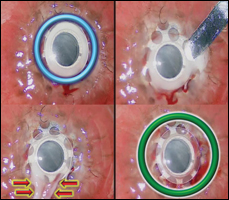

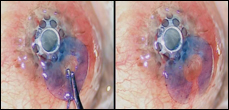

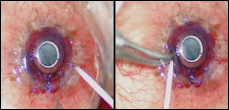
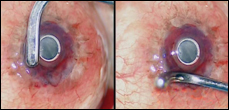
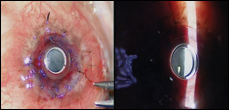
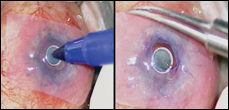



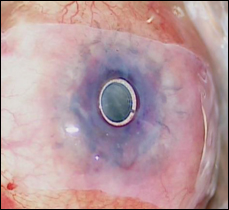
In this column, I describe the surgical technique of a keyhole anterior lamellar graft combined with cryopreserved amniotic membrane transplantation for corneal melt and 360° partial exposure of the KPro.
Technique
The anesthesia may be monitored anesthesia care or general anesthesia, depending on surgeon and patient preference. KPro corneal melt with back plate exposure requires surgical intervention (Figure 1). A lamellar keratoplasty is required to completely cover the exposed KPro back plate. The corneal melt is almost 360° around the stem of the collar button design of the keratoprosthesis, with exposure of the anterior surface of the titanium back plate (Figure 1). Additionally, there is complete circumferential covering of the stem with tissue debris, giving a white circular appearance to the central region of the KPro (Figure 1).
Before placing a lamellar graft, the space between the posterior surface of the front plate and the anterior surface of the back plate needs to be cleared of all tissue debris (Figure 1). A curved Crescent knife (Alcon) is used to initially dislodge the tissue debris from the stem and the undersurface of the front plate, and the tissue debris is then removed completely, as shown in Figure 1. Following this, sterile balanced salt solution is used to irrigate this area to further remove any tissue remnants.
Next, attention is directed to the donor cornea. The donor cornea is mounted in an artificial anterior chamber (Moria), and using an automated microkeratome, a donor lamellar graft is fashioned (Figure 2) with a thickness to match the space between the KPro front and back plates. To facilitate visualization of the lamellar graft edges, it is stained with trypan blue (VisionBlue) (Figure 2). Using a 3-mm trephine punch, a central opening is created in the lamellar graft to match the diameter of the central stem of the collar button of the KPro (Figure 2). A radial cut is then made in the donor lamellar graft to extend all the way to the central circular opening (Figure 3). This creates a donor keyhole lamellar disc (Figure 3).
The keyhole lamellar disc is then draped around the central stem of the KPro (Figure 4). The cut edges of the lamellar graft are approximated using interrupted 10-0 nylon sutures that pass through the episcleral tissue for firm anchorage to the underlying tissues (Figure 4). This results in a circular collar of donor lamellar graft that firmly drapes around the central KPro stem and completely covers the areas of corneal melt (Figure 4). Additionally, fibrin glue (Tisseel) is used to attach the lamellar graft to the ocular surface (Figure 5). A muscle hook is used to iron the lamellar graft surface to ensure uniform attachment of the donor graft to the underlying tissues (Figure 6). In addition to the fibrin glue, the lamellar graft edges are further attached to the underlying tissues using interrupted 10-0 nylon sutures (Figure 7). An intraoperative slit lamp examination confirms uniform attachment of the donor keyhole lamellar graft to the recipient ocular surface without any debris or air bubbles in the donor-recipient interface (Figure 7).
Next, a cryopreserved amniotic membrane is placed over the recipient ocular surface to cover the KPro with the attached keyhole lamellar graft and the surrounding ocular surface (Figure 8). A central opening in the amniotic membrane is made to match the optic part of the KPro to facilitate optimal vision without any tissue impediment (Figure 8). Fibrin tissue adhesive is used to attach the cryopreserved amniotic membrane to the newly created ocular surface (Figure 9). A muscle hook is used to smoothen the surface and ensure uniform attachment of the amniotic membrane (Figure 10). Figure 11 shows the intraoperative biomicroscopic view of the lamellar graft with overlying cryopreserved amniotic membrane. Figure 12 displays the completed view of the keyhole anterior lamellar graft with cryopreserved amniotic membrane with a central opening to facilitate vision through the KPro.
- References:
- Avadhanam VS, et al. Clin Ophthalmol. 2015;doi:10.2147/OPTH.S27083.
- Chang HY, et al. Cornea. 2015;doi:10.1097/ICO.0000000000000357.
- Homayounfar G, et al. Br J Ophthalmol. 2016;doi:10.1136/bjophthalmol-2015-307868.
- John T, ed. Lamellar Corneal Surgery. New York, New York: McGraw-Hill Companies; 2008.
- Robert MC, et al. Semin Ophthalmol. 2014;doi:10.3109/08820538.2014.959186.
- Rudnisky CJ, et al. Am J Ophthalmol. 2016;doi: 10.1016/j.ajo.2015.10.023.
- For more information:
- Thomas “TJ” John, MD, a clinical associate professor at Loyola University at Chicago and in private practice in Oak Brook, Tinley Park and Oak Lawn, Ill. He can be reached at email: tjcornea@gmail.com.
Disclosure: John reports he is a consultant for, is on the speakers bureau of and has a stock interest in Bio-Tissue.
